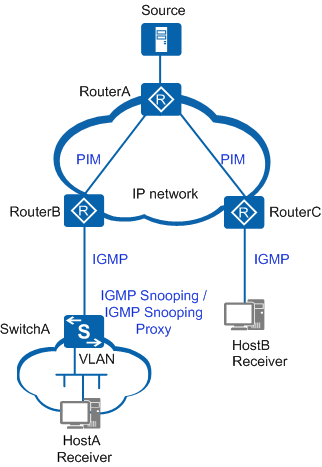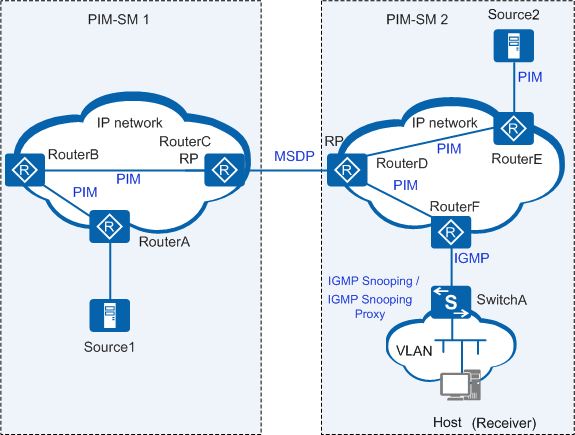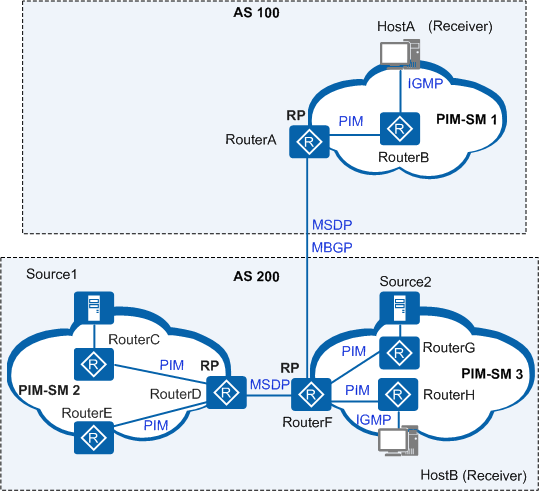Multicast Deployment on an IPv4 Network
This section describes typical multicast service scenarios on an IPv4 network and applications of multicast protocols. Configure multicast services based on the actual situations and service requirements on your network. This section provides only deployment of basic multicast services.
Before deploying IPv4 multicast services on a network, ensure that IPv4 unicast routes on the network are reachable.
Multicast Within a PIM Domain
On a small-scale network, all network devices and hosts belong to the same PIM domain. Figure 1 shows this type of multicast service deployment.
Protocol |
Application Position |
Purpose |
|---|---|---|
PIM (mandatory) |
PIM must be configured on all interfaces of Layer 3 multicast devices in the PIM domain, including all interfaces of RouterA, RouterB, and RouterC. For the configuration procedure, see IPv4 PIM Configuration. |
PIM sends multicast data from the multicast source to RouterB and RouterC, which are connected to multicast receivers. |
IGMP (mandatory) |
IGMP must be configured on user-side interfaces of Layer 3 multicast devices RouterB and RouterC. For the configuration procedure, see IGMP Configuration. |
IGMP allows receiver hosts to join or leave multicast groups, and allows RouterB and RouterC to maintain and manage group memberships. |
IGMP snooping and IGMP snooping proxy (optional) |
IGMP snooping and IGMP snooping proxy must be configured in VLANs on SwitchA, a device between a Layer 3 multicast device and user hosts. For the configuration procedure, see IGMP Snooping Configuration. |
IGMP snooping listens to IGMP packets exchanged between RouterB and HostA to create and maintain a Layer 2 multicast forwarding table. In this manner, SwitchA can control forwarding of multicast data packets on the Layer 2 network. IGMP snooping proxy allows SwitchA to act in place of RouterB to send IGMP Query messages and in place of hosts to send IGMP Report/Leave messages. |
Multicast Between PIM-SM Domains
A multicast domain can be divided into multiple isolated PIM-SM domains to facilitate the management of multicast resources, including multicast groups, multicast sources, and group members. To enable the PIM-SM domains to exchange multicast data, MSDP needs to be deployed between the PIM-SM domains, as shown in Figure 2.

MSDP is not required when PIM-SM uses the SSM model.
Protocol |
Application Position |
Purpose |
|---|---|---|
PIM-SM (mandatory) |
PIM-SM must be configured on all interfaces of Layer 3 multicast devices in the PIM-SM domains, including all interfaces of Routers A to F. For the configuration procedure, see Configuring IPv4 PIM-SM. |
PIM-SM sends multicast data from multicast sources Source1 and Source2 to RouterF connected to multicast receivers. Receiver hosts proactively join a multicast group, and multicast data is forwarded to the receiver hosts through rendezvous points (RPs) in the PIM-SM domains. |
IGMP (mandatory) |
IGMP must be configured on user-side interfaces of Layer 3 multicast device RouterF in the PIM-SM domains. For the configuration procedure, see IGMP Configuration. |
IGMP allows receiver hosts to join or leave multicast groups, and allows SwitchD to maintain and manage group memberships. |
MSDP (mandatory) |
MSDP must be configured on the RP in each PIM-SM domain, that is, RouterC and RouterD. For the configuration procedure, see MSDP Configuration. |
MSDP transmits multicast data between PIM-SM1 and PIM-SM2. Host in PIM-SM2 can receive data from Source1. |
IGMP snooping and IGMP snooping proxy (optional) |
IGMP snooping must be configured in VLANs on SwitchA, a device between a Layer 3 multicast device and user hosts. For the configuration procedure, see IGMP Snooping Configuration. |
IGMP snooping listens to IGMP messages exchanged between RouterF and hosts to create and maintain a Layer 2 multicast forwarding table. In this manner, SwitchA can control forwarding of multicast data packets on the Layer 2 network. IGMP snooping proxy allows SwitchA to act in place of RouterF to send IGMP Query messages and in place of hosts to send IGMP Report/Leave messages. |
Inter-AS Multicast

Before configuring MBGP between ASs, configure BGP between the ASs.
Protocol |
Application Position |
Purpose |
|---|---|---|
PIM-SM (mandatory) |
PIM-SM must be configured on all interfaces of Layer 3 multicast devices in the PIM-SM domains, including all interfaces of Routers A to H. For the configuration procedure, see Configuring IPv4 PIM-SM. |
PIM-SM sends multicast data from multicast sources Source1 and Source2 to RouterB and RouterH, which are connected to multicast receivers. After receiver hosts join a multicast group, multicast data is forwarded to the receiver hosts through RPs in the PIM-SM domains. |
IGMP (mandatory) |
IGMP must be configured on user-side interfaces of Layer 3 multicast devices RouterB and RouterH in the PIM-SM domains. For the configuration procedure, see IGMP Configuration. |
IGMP allows receiver hosts to join or leave multicast groups, and allows RouterB and RouterH to maintain and manage group memberships. |
MBGP (mandatory) |
MBGP must be configured on RouterA and RouterF located at the AS borders. For the configuration procedure, see BGP Configuration in the S2720, S5700, and S6700 V200R019C10 Configuration Guide - IP Unicast Routing. |
MBGP sends multicast data from multicast sources Source1 and Source2 to receivers in another AS based on an independent multicast routing table. |
MSDP (mandatory) |
MSDP must be configured on the RP in each PIM-SM, that is, RouterA, RouterD, and RouterF. For the configuration procedure, see MSDP Configuration. |
MSDP transmits multicast data among PIM-SM1, PIM-SM2, and PIM-SM3. |


